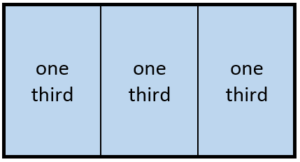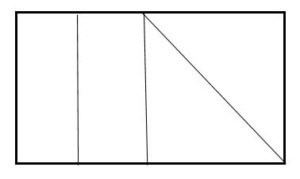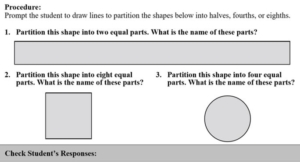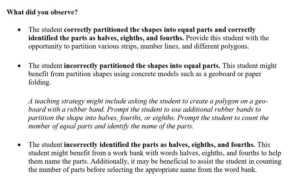MAFS.2.G.1.3 Partition circles and rectangles into two, three, or four equal shares, describe the shares using the words halves, thirds, half of, a third of, etc., and describe the whole as two halves, three thirds, four fourths. Recognize that equal shares of identical wholes need not have the same shape.
Cognitive Complexity Level: 1-Recall
[divider] [/divider] Students are able to…
-
- Recognize that when a rectangle is cut into three equal pieces, each piece is equal to one third of the whole rectangle.

- In the rectangle above, students should describe the whole as three thirds.
- Understand that equal shares may be different shapes within the same whole. For example, all of these equal shares cover the same area even though they are different shapes.

- Recognize that when a rectangle is cut into three equal pieces, each piece is equal to one third of the whole rectangle.
[divider] [/divider] Students are able to…because teachers:
- Provide opportunities for the students to explore the concept of fair shares.
- Introduce fractions using the area model; including manipulatives and paper for students to cut. They should be circles or rectangles.
- Provide opportunities to talk to each other about what they are learning.
[divider] [/divider] Questions to ask students:
- Ask: Show the student a model of a rectangle that is divided into thirds. If you ate one piece of this cake, what fraction of the cake would you be eating? Explain your thinking.
- Sample answer that would indicate understanding: I would be eating one third of the cake. I know this because there are 3 equal pieces in the whole cake and I am eating one of those pieces.
- Sample answer that indicates an incomplete understanding or a misconception: I would be eating one piece of the cake. OR I would be eating one half or one twos. I know this because I am eating one piece and there are two pieces left.
- Ask: Give the student a picture of a rectangular cake and ask them to partition it into fourths. After they partition it into fourths ask them what fraction of the cake they would be eating if they ate the whole thing.
- Sample answer that would indicate understanding: The students draws lines or folds the paper to make 4 equal pieces and then says that he/she would be eating four fourths because there are four equal pieces in the whole and I would be eating all of them.
- Sample answer that indicates an incomplete understanding or a misconception: The student draws lines to make 4 pieces that are clearly not equal. The student still says that they are eating four fourths, because they are not realizing that the pieces need to be equal in size.
- Ask: Show students the following picture and ask them to circle the pictures that show fourths and explain why or why not they are fourths.

- Sample answer that would indicate understanding: The student says that all 3 show fourths. The first one has four equal pieces that look the same. The second one also has four equal pieces. They are just facing different directions. The third one also has four equal pieces. They do not look the same but they are all the same amount of the shape.
- Sample answer that indicates an incomplete understanding or a misconception: The student does not choose the second one because the pieces are not all going the same way within the whole and/or the student does not pick the third one because the pieces do not all look the same or have the same shape.
[divider] [/divider] Additional Resources:
Additional in depth content knowledge
Video: Partition a shape into equal shares
[divider] [/divider] Sample Formative Assessment Tasks:
Only use 2,3 or 4 parts with this task:


[divider] [/divider] Resources/Tasks to Support Your Child at Home: